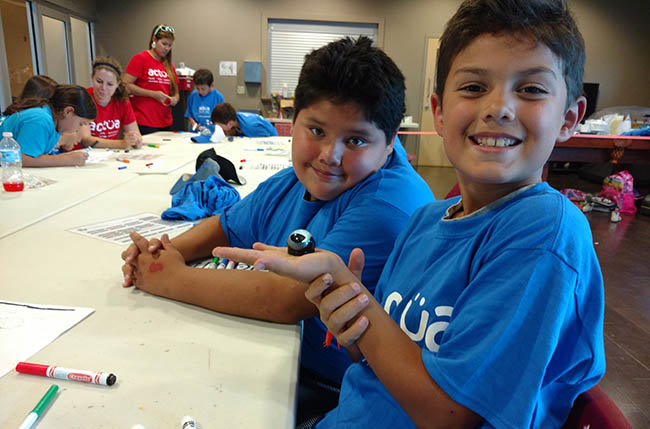Science camp helps youth build their own ideas

By Colin Graf
AAMJIWNAANG FIRST NATION –Where will you find robots, wind turbines, flying rockets, and kids in the same place at the same time? Well…at a science day camp that’s taking elementary-age children on a series of adventures designing and building their own engineering creations here this summer.
The program, run by the Actua charitable group, is introducing First Nations children across Canada to STEM (Science, Technology, Engineering, and Math) careers with fun hands-on activities in a day camp setting. Kids create maps, launch rockets, learn computer coding skills to direct robots, build wind turbines, and make plans to help clean the world’s oceans, says Actua camp leader Chelsea Pike, of Ottawa.
“Kids just love what we do,” she says, as small groups of children create paths on paper for small robots known as Ozobots, which sense differing colours and respond as the colours on their marker-drawn paths change in a large room at the Aamjiwnaang community centre.
“I thought this was going to be boring,” says Dion Maness, 11, but changed his mind after the program got started. “This is fun, this is cool,” he said.
Some kids may never have seen the robots before, but others have met them at school or previous camps. However, no one is ever disappointed to play with them again, Pike says. “Yay, we’re doing that again,” is a common response, she tells Anishinabek News.
The Actua team members visiting Aamjiwnaang are winding up their summer in the south-western Ontario community after six other visits across Ontario and Quebec, including Missanabie and Six Nations, says Pike. The program also has an ecological and health side. Tag games help teach kids to protect themselves from infection. Wind turbines help teach about global warming and green energy. Other chasing games teach how food chains work in the natural world.
The week usually wraps up with an open house for parents and community members, giving them a chance to see what the kids have been doing.
Some of the best moments are when the participants take the projects in their own direction, Pike says. She remembers one group at a another First Nations using a computer code language Scratch and some mini-controllers to make an obstacle course for robots, like the old table-top game Operation. Another highlight was discovering that jujubes conduct electricity when kids used them to play music on an electronic keyboard. “We help them build their own ideas,” she explains.
The children often remember their experiences with the science camp and clearly value them, Pike says. She recalls a girl from Iqaluit spotting her at a music festival in Ottawa who came running to her. Pike had been in the girl’s class in school for under two hours.
Aamjiwnaang has hosted about nine ACTUA camps in summers since 2012, says Winterson Rogers, organizer of the events for the First Nation. The kids are always really engaged by the activities, and the camp helps stimulate the young minds during the summer break from school, he says. He has seen kids come through who were interested in science before the camp, but “they didn’t really know it could be this much fun,” Rogers says. He hears kids at the end of the week say thing like, “I’m going to invent things,”, and “I’m going to be a scientist.” Many times they leave with their interest even higher than before the camp, he says.
The camp is sponsored by Sarnia-area industries such as Imperial Oil, Rogers says.
Actua has brought STEM learning to hundreds of Indigenous communities and tens of thousands of Indigenous youth over the last 20 years, in consultation with national organizations like Indspire, the Aboriginal Human Resource Council, Inuit Tapiriit Kanatami (ITK) and others, according the the group’s website.


